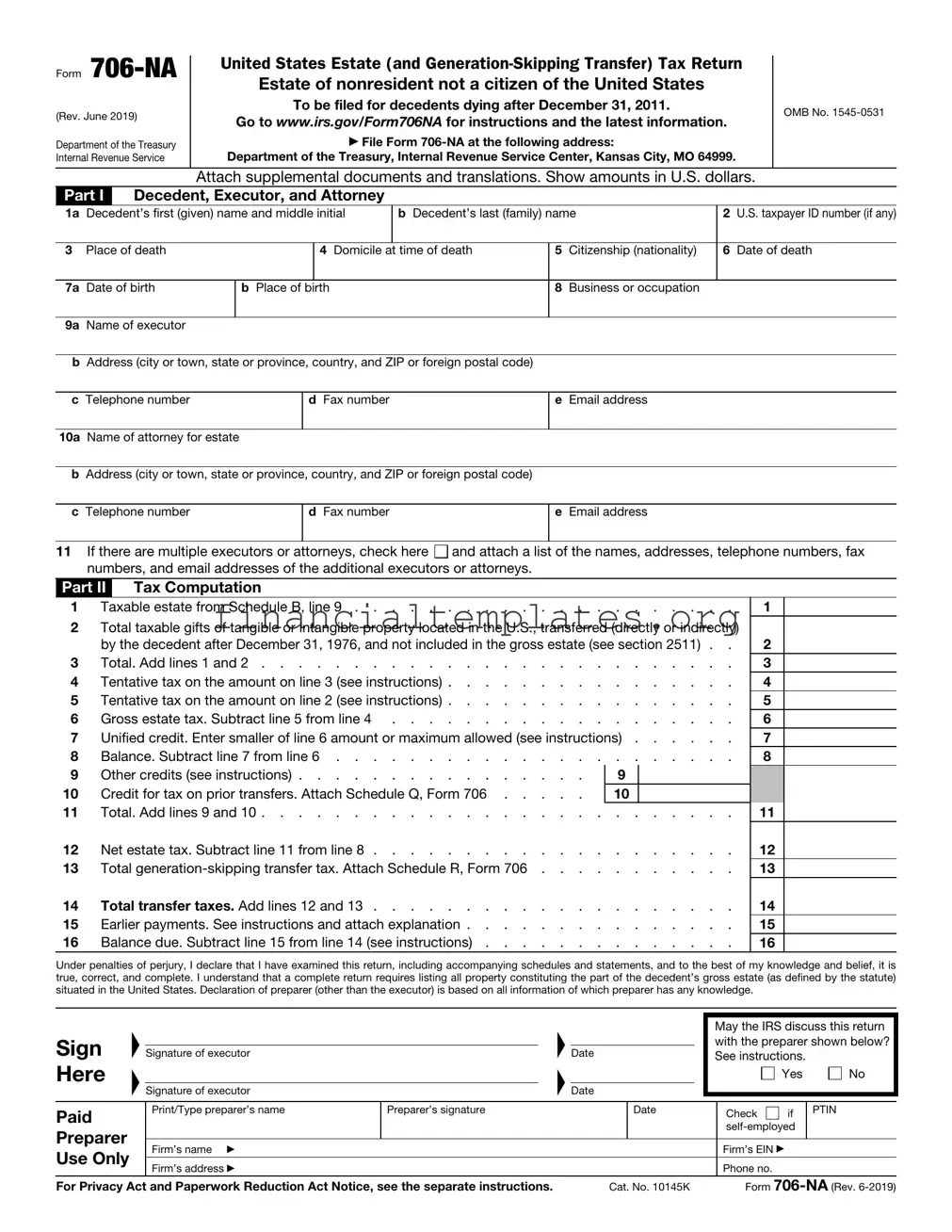box) for the executor. If licensed to practice in the United States, I am not under suspension or disbarment from practice before the Internal
Revenue Service and am qualified to practice in the state shown above. |
If not licensed to practice in the United States, check here. |
Signature |
|
CAF number |
|
Date |
|
Telephone number |
|
|
|
|
|
|
|
|
|
|
|
|
|
|
|
|
|
|
|
Yes |
No |
|
|
|
|
|
|
Yes |
No |
1a |
Did the decedent die testate? |
|
|
7 |
Did the decedent make any transfer (of |
|
|
b Were letters testamentary or of administration |
|
|
|
property that was located in the United States |
|
|
|
|
|
at either the time of the transfer or the time of |
|
|
|
granted for the estate? |
|
|
|
|
|
|
|
|
|
death) described in section 2035, 2036, 2037, |
|
|
|
If granted to persons other than those filing the |
|
|
|
|
|
|
|
|
|
or 2038? See the instructions for Form 706, |
|
|
|
return, include names and addresses on page 1. |
|
|
|
Schedule G |
|
|
2 |
Did the decedent, at the time of death, own any: |
|
|
|
If “Yes,” attach Schedule G, Form 706. |
|
|
a |
Real property located in the United States? . |
|
|
8 |
At the date of death, were there any trusts in |
|
|
b |
U.S. corporate stock? |
|
|
|
existence that were created by the decedent |
|
|
c |
Debt obligations of (1) a U.S. person; or (2) the |
|
|
|
and that included property located in the |
|
|
|
United States, a state or any political |
|
|
|
United States either when the trust was |
|
|
|
subdivision, or the District of Columbia? . |
|
|
|
created or when the decedent died? . . . |
|
|
d Other property located in the United States? . |
|
|
|
If “Yes,” attach Schedule G, Form 706. |
|
|
|
|
|
|
|
3 |
Was the decedent engaged in business in the |
|
|
9 |
At the date of death, did the decedent: |
|
|
|
United States at the date of death? . . . |
|
|
a |
Have a general power of appointment over |
|
|
4 |
At the date of death, did the decedent have |
|
|
|
any property located in the United States? . |
|
|
|
access, personally or through an agent, to a |
|
|
b |
Or, at any time, exercise or release the power? |
|
|
|
safe deposit box located in the United States? |
|
|
|
If “Yes” to either a or b, attach Schedule H, |
|
|
5 |
At the date of death, did the decedent own |
|
|
|
Form 706. |
|
|
|
|
|
|
|
any property located in the United States as a |
|
|
10a |
Have federal gift tax returns ever been filed? . |
|
|
|
joint tenant with right of survivorship; as a |
|
|
|
|
|
|
|
b |
Periods covered ▶ |
|
|
|
|
|
tenant by the entirety; or, with surviving |
|
|
|
|
|
|
|
|
|
|
|
|
|
|
|
|
|
|
spouse, as community property? . . . . |
|
|
c |
IRS offices where filed ▶ |
|
|
|
|
|
If “Yes,” attach Schedule E, Form 706. |
|
|
11 |
Does the gross estate in the United States |
|
6a |
Had the decedent ever been a citizen or resident |
|
|
|
|
|
|
include any interests in property transferred to |
|
|
of the United States? See instructions . . . |
|
|
|
a “skip person” as defined in the instructions |
|
b If “Yes,” did the decedent lose U.S. citizenship or |
|
|
|
for Schedule R of Form 706? |
|
|
|
residency within 10 years of death? See instructions |
|
|
|
If “Yes,” attach Schedules R and/or R-1, Form 706. |
|
|
Schedule A. Gross Estate in the United States (see instructions) |
|
|
|
|
|
Yes |
No |
Do you elect to value the decedent’s gross estate at a date or dates after the decedent’s death (as authorized by section 2032)? ▶
To make the election, you must check this box ‘‘Yes.’’ If you check ‘‘Yes,’’ complete all columns. If you check ‘‘No,’’ complete columns (a), (b), and (e); you may leave columns (c) and (d) blank or you may use them to expand your column (b) description.
1 |
Gross estate in the United States (Schedule A total) |
1 |
|
2 |
Gross estate outside the United States (see instructions) |
2 |
|
3 |
Entire gross estate wherever located. Add amounts on lines 1 and 2 |
3 |
|
4 |
Amount of funeral expenses, administration expenses, decedent’s debts, mortgages and liens, and |
|
|
|
losses during administration. Attach itemized schedule (see instructions) |
4 |
|
5 |
Deduction for expenses, claims, etc. Divide line 1 by line 3 and multiply the result by line 4 . . . . |
5 |
|
6 |
Charitable deduction (attach Schedule O, Form 706) and marital deduction (attach Schedule M, Form |
|
|
|
706, and computation) |
6 |
|
7 |
State death tax deduction (see instructions) |
7 |
|
8 |
Total deductions. Add lines 5, 6, and 7 |
8 |
|
9 |
Taxable estate. Subtract line 8 from line 1. Enter here and on line 1 of Part II |
9 |
|


